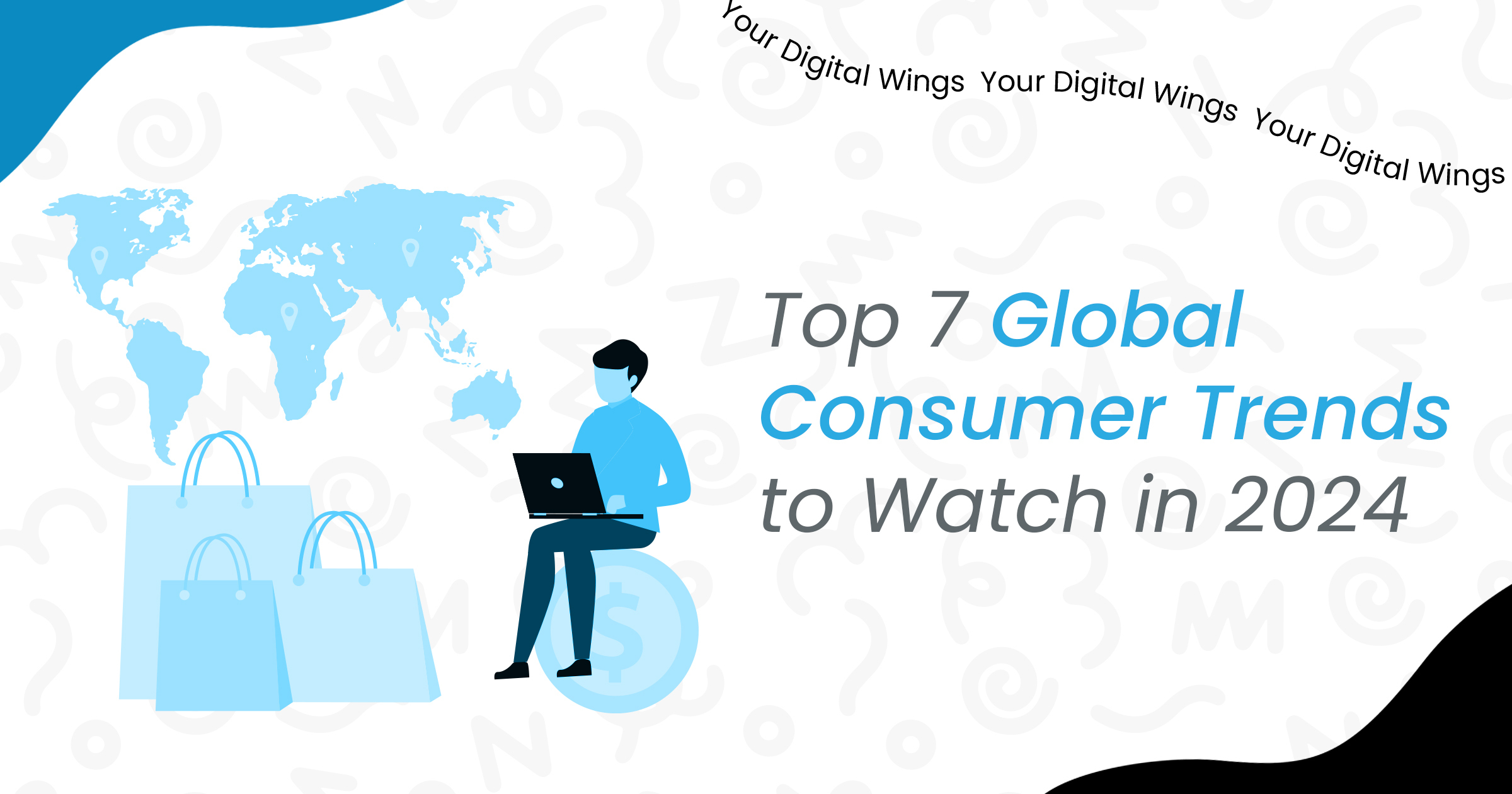To keep ahead of global consumer trends, businesses must stay at the forefront of global consumer behavior. In 2024, several key trends are expected to shape the market, driven by technological advances, changing values, and shifting economic factors. This guide covers seven major global consumer trends that will be important for businesses to monitor globally in 2024 and provides insights and strategies for them to adjust their plans so they can remain competitive.
Businesses need a grasp of psychological influences on consumer behavior for customer preferences and expectations to re-align their offerings or strategies accordingly. The contents of this article take into account the major changes that have occurred in customers’ behavior and what has brought about these transformations. This way, organizations can know what modern consumers want and satisfy them better than everyone else does, thus causing expansion.
1. Sustainability and Ethical Consumption
In 2024, sustainability and ethical consumption will be more than just buzzwords. Global consumer trends will be integral to consumer decision-making. Today’s customers are increasingly informed about their purchases’ environmental and social consequences. They prefer brands that prioritize sustainability, transparency, and ethical practices.
- Growing Eco-awareness: Global consumer trends and consumers are now more aware of climate change and environmental destruction and are, hence, looking for eco-friendly and sustainable products.
- Social Obligations: Brands must support various social concerns such as fair labor conditions, local community development, and other factors of the sort.
- Regulatory Environment: Governments and international organizations have been introducing stringent regulations on sustainability matters, forcing businesses to embrace green approaches.
Implications for Business
- Sustainable Products: Businesses must spend on sustainable product development. These companies should use eco-friendly materials and reduce waste.
- Transparent Practices: Consumers will trust more when they see transparency in sourcing, production, and supply chain processes.
- Corporate Social Responsibility (CSR): Sound CSR initiatives boost brand reputation and customer loyalty.
Case Study: Patagonia
Patagonia, an outdoor clothing brand, has set a benchmark for sustainability in the industry. Their commitment to environmental activism, sustainable materials, and ethical production has resonated with Global consumer trends, driving brand loyalty and sales.
2. Digital and AI Integration
The use of artificial intelligence (AI) and digital technologies is changing how customers relate to brands. Digitization and the development of AI have augmented the customer experience through personalized recommendations, chatbots, and virtual assistants.
- Data-Available Marketing. There is enough consumer information to allow for more precise target marketing and personalization. Using AI to analyze consumer data for personalized messages can increase engagement and conversion rates.
- Enhanced Customer Service: AI-powered chatbots and virtual assistants can offer instant support, significantly improving customer satisfaction.
- Data-Driven Insights: Businesses can use AI to gain deep insights into global consumer trends and behavior/preferences, guiding strategic decision-making processes.
Case Study: Amazon
Amazon’s utilization of AI for personalized recommendations, dynamic pricing, and efficient logistics has changed the face of retailing. In a competitive market, they still stand out because of their commitment to being digitally innovative.
3. Health and Wellness Focus
Consumers are prioritizing health and wellness over all other buying decisions and lifestyles. This means adopting various healthier living processes, from personal psychic culture to holistic rehabilitation.
- Pandemic Impact: COVID-19 raised stewards of health and wellness, pointing to the growing realization that consumers are giving importance to their care.
- Holistic Approach: Consumers take a 360-degree approach to wellness, looking for products and services to improve their overall well-being.
- Tea Time: Modern Health tech must integrate with health apps and wearable technology to empower consumers to take control of their care.
Business Implications
- Health-Centric Products: Firms should create products that support health and wellness from food to fitness to everything in between.
- Emotional well-being: A product or service that supports mental health, such as a stress-busting app or program to improve happiness, can tap into the sympathy of conscious global consumer trends.
- Tech Integration: Incorporating health tech into products and services to drive user engagement and satisfaction.
Case Study: Fitbit
Fitbit, the leading wearable fitness brand, has done well to capitalize on the health and wellness focus. With personalization comes an ever-evolving gamut of services, as Apple included features like activity tracking alongside sleep (in the upcoming WatchOS 7) and stress monitoring with OS14 for some devices.
4. Personalization and Customer Experience
In international buying habits, personalization is no longer a luxury but a necessity in the present-day world of fierce competition. Brands should understand global consumer trends and habits and perform specific actions that satisfy individual spectators’ expectations.
- Consumer Expectations: Personalization improves the interface quality from the customer’s perspective since they receive only meaningful interactions.
- Technological Advancements: AI and data analysis help organizations provide targeted solutions to specific groups of customers on a large scale.
- Competitive Differentiation: Personalization distinguishes brands in a competitive market, winning customers’ loyalty and creating an opportunity for another business cycle.
Business Implications
- Personalized Marketing: Implementing marketing communication strategy in which segmented mass messages are produced using big data analysis.
- Customized Products: Providing tangible and intangible goods and services that can be developed according to the buyer’s specifications.
- Seamless Experiences: The process of making customers’ interactions homogenous and unique across the web, mobiles, applications, and stores.
Case Study: Netflix’s
Netflix account recommendation system is one of the best examples of suitable personalization. Based on the data on viewing behavior and choice preferences, Netflix provides accurate and valuable recommendations for its users, increasing viewers’ satisfaction.
5. Economic Factors Influencing Spending
Changes in consumer spending behavior are greatly influenced by matters such as inflation, employment rates, and disposable income. Knowledge of such factors is imperative to enable organizations and companies to modify strategies and products as they factor in time.
- Inflation: This invariably makes certain a change in the priority placed on spending in certain areas of the economy through alteration of the consumer’s Socioeconomic impacts on purchasing decisions power due to rising prices.
- Employment Rates: Unemployment affects consumer confidence and their readiness to spend more money.
- Income Disparities: Human beings master various classifications, which results in them spending different amounts of income for the same goods depending on their economic status.
Business Implications
- Value Proposition: Consumers are concerned with value, which signifies that organizations must prioritize value-for-money goods.
- Flexible Pricing: Using control elements, including offering discounts and promotions to attract sensitive price and global consumer trends.
- Economic Insights: Estimating various economic factors when it is required to foresee alterations in buyer behavior and modify the tactics.
Case Study: Walmart
Probably the single biggest reason people turn to Walmart, especially in times of recession, is the company’s clear corporate strategy of offering the lowest prices possible. On price concerns, they will always go for the best prices, and other money-conscious customers will buy the best value.
6. Technological Advancements in Shopping
Current advancements in the technological field are affecting the retail industry by providing new ways to buy products and communicate with brands. These innovations, from Augmented Reality (AR) to Blockchain, are improvising and revolutionizing the shopping spree.
- Convenience: There are available shopping technologies, which include online shopping and mobile applications.
- Innovation: Technological improvement is constant to create changes in shopping experiences and solutions.
- Consumer Adoption: Technology awareness and its increase in usage and acceptance by the buyer are essential for getting clients interested in technology-supported purchasing.
Business Implications
- Omnichannel Retailing: Creating an omnichannel plan that combines customers’ online and offline purchasing patterns.
- AR and VR: Applying AR and VR technologies to implement interactive and virtual buying and selling.
- Blockchain: Blockchain application for supply chain management and secure transactions.
Case Study: IKEA
Another implementation of AR technology was made by IKEA, which developed and launched an application for customers to see how furniture will fit in their apartments. This is a good way for Amazon to use technology to improve the shopping experience and minimize the rate of returns.
7. Cultural Shifts and Diversity
Cultural factors such as cultural change and rising diversity affect consumers’ and global consumer trends behavior and expectations. Companies that proactively champion diversity and inclusion have a chance of engaging a larger population and thus creating better bonds.
- Globalization: Global relations, called globalization, have opened people up to differences in other parts of the world.
- Social Movements: Equality and social movements are affecting consumers’ expectations and brands’ perceptions.
- Demographic Changes: Demographic variables are constantly changing, including the aging population and the growing globalization of diversity, which influence consumers’ behavior and global consumer trends.
Business Implications
- Inclusive Marketing: How to build marketing campaigns corresponding to viewers’ whereabouts, outlooks, and ethnicities.
- Product Diversity: Providing a diverse, culturally sensitive array of products that enable people of different cultural backgrounds to access products they require.
- Diverse Workforce: Recruiting a diverse talent pool to reflect consumers of its products and to ensure organizational competence understands the consumers.
Case Study: Nike
Nike is indeed consciously trying to support the cause of diversity and inclusion in its advertisements and products. Its Eyeful ‘Equality’ campaign, which champions social justice in contemporary society, has impressed global society.
Conclusion
The global consumer landscape in 2024 is characterized by dynamic shifts driven by sustainability, digital integration, and health consciousness. Businesses must prioritize eco-friendly practices, leverage AI for personalized customer experiences, and innovate in health and wellness offerings to meet evolving consumer demands. Partnering with distributors and retailers, adapting to economic fluctuations, embracing technological advancements in shopping, and fostering cultural inclusivity are also crucial for staying competitive. For expert guidance on navigating these trends and optimizing business strategies, contact Cretesol Tech. Our team is equipped to help businesses thrive in this ever-evolving global consumer trends environment.
FAQs
What are the major global consumer trends in 2024?
In 2024, major global consumer trends include sustainability and ethical consumption, digital and AI integration, health and wellness focus, personalized customer experiences, economic factors influencing spending, technological advancements in shopping, and cultural shifts towards diversity and inclusivity.
How can businesses adapt to these emerging trends?
Businesses can adapt to these emerging trends by prioritizing sustainable practices, leveraging AI for personalized marketing and customer interactions, developing health-centric products, emphasizing value amidst economic changes, integrating innovative technologies in retail experiences, and embracing cultural diversity in marketing strategies and product offerings.
What impact do these trends have on marketing strategies?
These trends necessitate agile, data-driven, and customer-centric marketing strategies. Effective strategies will focus on sustainability messaging, personalized content delivery through AI, wellness-oriented campaigns, value-driven promotions during economic shifts, tech-enhanced shopping experiences, and inclusive branding that resonates across diverse consumer demographics.

 United Arab Emirates
United Arab Emirates